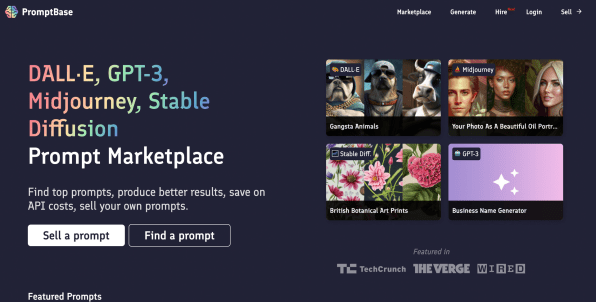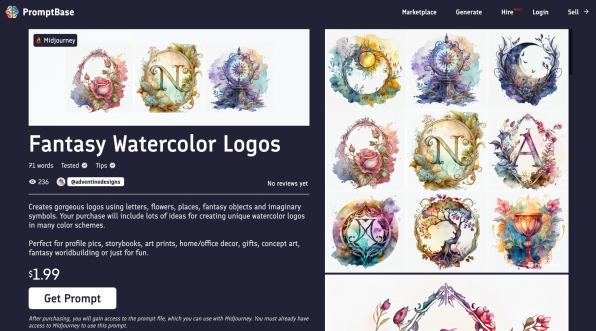The wild world of PromptBase, the eBay for generative AI prompts
The old saying is that the best person to be in a gold rush is the one selling the shovels. Well, what about the person who owns the shovel store?
It’s not far off from what developer Ben Stokes is currently doing within the booming world of generative artificial intelligence right now. Stokes didn’t make another AI tool. Instead, he’s running a marketplace for the prompts that go into the AI. It’s called PromptBase, and according to Stokes, there’s been a lot of early interest.
“There’s a pretty healthy marketplace going on,” he says. “There’s probably about double the amount of buyers compared to sellers right now on there.”
To understand what Stokes’ website PromptBase is doing, you first need to understand how generative AI works. Whether an AI tool produces images (as with DALL-E 2) or text (ChatGPT), the programs require a prompt. These prompts are strings of text and could be as simple as “a skeleton on skateboard” or as complex as “happy small cute skeleton on a longboard, doing a flip, pixar, hyperrealistic, bright colors, 8k.” It’s common for these prompts to balloon out into dozens upon dozens of words as users try and get an AI to create an image that matches the one in their heads. Very quickly, users have figured out that talking to machines requires a certain skill.
Which is where a marketplace for that skill comes in.

Stokes says that he had the idea for PromptBase while building another project, called Paper Website, which uses AI to convert handwritten text into blog posts. “I wanted to buy a battle-tested prompt that could basically, you know, correct handwriting mistakes,” he says.
PromptBase, a site that scratches that exact itch, rolled over 11,000 users this month, Stokes says. Although the idea of selling these prompts may seem silly—at first—in practice, it’s not so different from other human-to-machine translation services such as search engine optimization jobs, which have existed for more than a decade, where companies hire teams to help their online content rank higher in Google’s search results.
But generative AI has quickly become a lot more controversial than SEO. AI prompts, just as they’ve started to evolve into their own industry, have already been met with intense backlash from artists who see AI art as several forms of theft all rolled into one.
First, there’s the fact that many of the popular generative AI services don’t disclose where their training data comes from. But users are able to create passable images in the style of specific artists, which seems to indicate that the AI has studied that artist’s images. There are also things that the AI can’t generate, such as tightly trademarked material or hateful content, which means these companies are making some kind of judgment call about which artists and images they’re allowing their AI to study.
PromptBase has a review process, as well, actually. Stokes says that all of the prompts listed on the marketplace are reviewed by humans, and the ones that don’t make the cut are usually turned down because they don’t reliably produce consistent results.
“There’s lots of testing that goes around to make sure that it does work,” he says. “And if it doesn’t, then it gets declined. It doesn’t go on the website.” He adds that, so far, he hasn’t had to decline any submissions for overtly sexual or hateful content.

But there’s also the question of how generative AI automate labor. As the demands of large social platforms have come to require more visual content from users—at a higher level of professionalism—digital artists have become both more important than ever, but also, frustratingly, more disposable. So it doesn’t seem like an accident that a large chunk of AI art is being used for things like YouTube thumbnails or digital marketing materials.
“[AI prompts] can be applied to really serious business applications that have a real need. For example, a prompt that can generate T-shirt designs. That’s incredibly valuable for a company that’s creating handcrafted T-shirts,” Stokes says. “If you have a good problem, then it is very valuable to a certain business.”
That value for businesses has caused a huge uptick in interest, which, in turn, has led to several blowups over generative AI in the past few months. Stock image site Shutterstock was met with pushback when it announced a partnership with OpenAI in October. Artists on DeviantArt revolted after the site said it would start using user-generated content to train an AI service. (The site later backpedaled after mass outcry.) And just this month, users on Artstation, an online portfolio and marketplace for artists, protested against AI art being allowed on the site.
Dave Rapoza, an artist that has worked on concept art for such games as Marvel’s Spider-Man and films like X-Men: Days of Future Past, spoke out on Twitter about Artstation’s blind eye to AI art on the platform. He tells Fast Company that he doesn’t even necessarily hate AI as something for people to play with, but shouldn’t be something that people can profit from.
“It should be the same exact thing as music sampling,” he says. “You can’t just sample any song you want and then put it out and be like, ‘I’m gonna make money from this.’ You still have to pay for that. And you should have to pay that when it comes to artists.”
Artists have been accusing the people selling prompts of going to Artstation’s front page and trying to reverse engineer the trending artwork on the site with an AI and then selling it for cheaper. If you visit Artstation right now, its homepage, which normally shows off a grid of different creations, is now awash in anti-AI slogans. In fact, a rumor spread that the anti-AI images on Artstation were actually causing AI to generate them themselves if you fed an AI the prompt “trending on Artstation,” but the datasets for these tools don’t update that fast. (I tested out the phrase “trending on Artstation” in Midjourney to see what would happen, and it spit out four abstract pictures of a fantasy landscape.)
“If one art director goes on there and sees an AI portfolio, and doesn’t have the eye to understand what an AI image is, and thinks they’re hiring this artist that can produce all of these images, and then they can’t do that or they under-deliver,” Rapoza says, playing out the scenario, “it would just look bad for all of us.”
Rapoza likens generative AI art to someone building a car out of stolen parts. Just because you source all the pieces from other people’s cars doesn’t make the new car your property. In this analogy, Stokes’ PromptBase would be something of a content chop shop.
Stokes says that he doesn’t see PromptBase as a marketplace for images, just the instructions for making them. He adds that he has not blocked any submissions to the site for copyright reasons. “I would argue it’s not too dissimilar to buying a tutorial to learn how to draw in a specific style,” he says. “Right now you can’t copyright a style, but I definitely look forward to further clarification around copyright in the AI image space.”
The other issue is that in the world of AI, there’s no limit to how fast and how cheaply labor can be automated. And it’s unclear exactly how long we’ll even need humans who can craft intricate prompts to get what we want.
I recently purchased a prompt on PromptBase to see how the service worked. The one I chose was called “Pixar Cute Characters,” and it was created by a user named mrdan. It cost $1.99 and was specifically created for the Midjourney AI tool. The string of 59 words did as it was advertised, reliably creating characters that looked like they had come out of a Pixar film.
But on the page for mrdan’s “Pixar Cute Characters,” there were a few examples included of what the prompt might generate. And the Midjourney AI can now iterate images not just from text prompts, but from existing images. So I took one of mrdan’s example images, a cartoon monkey stylized like it came from a Pixar film, and, for no cost at all, fed that into Midjourney, which was able to spit out four similar images.
Stokes says that he isn’t worried about a need for human-made prompts. “Some people say that the prompt engineer is the final job before the machines take over—you know, any industry, whether it be medicine, law, agriculture, movies,” he says. “I think that’s when having battle-tested, well-crafted prompts that produce consistent output is genuinely required.”
But Stokes might be wrong. The final job might be the AI working for itself—with no humans involved at all.
(62)



